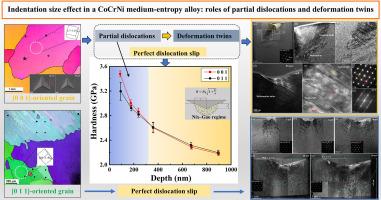CoCrNi中熵合金的压痕尺寸效应:部分位错和变形孪晶的作用
IF 12.8
1区 材料科学
Q1 ENGINEERING, MECHANICAL
引用次数: 0
摘要
本文采用纳米压痕实验和透射电镜研究了CoCrNi中熵合金的压痕尺寸效应(ISE)。本文章由计算机程序翻译,如有差异,请以英文原文为准。

Indentation size effect in a CoCrNi medium-entropy alloy: roles of partial dislocations and deformation twins
In this study, we investigated the indentation size effect (ISE) in a CoCrNi medium-entropy alloy using nanoindentation experiments and transmission electron microscopy (TEM) observations. Interestingly, the depth-hardness curves of two grains with different crystal orientations exhibit a crossover phenomenon together with orientation-dependent twinning behaviour. Comprehensive TEM characterization revealed that plastic deformation was accommodated by perfect dislocation slip in the [0 1 1]-oriented grains, whereas it involved dislocation slip, stacking faults, and deformation twins in the [0 0 1]-oriented grain. Partial dislocation slip was found to dominate in the [0 0 1]-oriented grain at very small depths, thereby suppressing dislocation motion and cross-slips, resulting in a higher dislocation density and increased hardness. A modified Nix-Gao model, incorporating partial dislocations with a restriction factor, is proposed to account for the ISE differences between the two grains. Despite substantial twinning in the [0 0 1]-oriented grain at higher loads, the contribution of deformation twins to dislocation accumulation is negligible. The present work highlights the critical roles that partial dislocations play and how they influence the ISE in low stacking-fault energy alloys.
求助全文
通过发布文献求助,成功后即可免费获取论文全文。
去求助
来源期刊

International Journal of Plasticity
工程技术-材料科学:综合
CiteScore
15.30
自引率
26.50%
发文量
256
审稿时长
46 days
期刊介绍:
International Journal of Plasticity aims to present original research encompassing all facets of plastic deformation, damage, and fracture behavior in both isotropic and anisotropic solids. This includes exploring the thermodynamics of plasticity and fracture, continuum theory, and macroscopic as well as microscopic phenomena.
Topics of interest span the plastic behavior of single crystals and polycrystalline metals, ceramics, rocks, soils, composites, nanocrystalline and microelectronics materials, shape memory alloys, ferroelectric ceramics, thin films, and polymers. Additionally, the journal covers plasticity aspects of failure and fracture mechanics. Contributions involving significant experimental, numerical, or theoretical advancements that enhance the understanding of the plastic behavior of solids are particularly valued. Papers addressing the modeling of finite nonlinear elastic deformation, bearing similarities to the modeling of plastic deformation, are also welcomed.
 求助内容:
求助内容: 应助结果提醒方式:
应助结果提醒方式:


